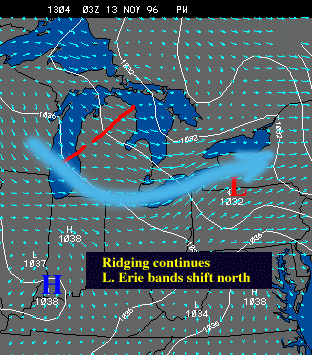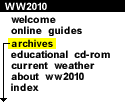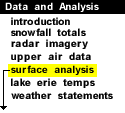
|
By late evening on November 12, 1996 (03z), the surface weather map looks nondescript. The high pressure from Illinois is making progress eastward and, as seen in the isobaric field, the curvature of the pressure field implies anticyclonic flow is taking over in the western lower lakes through southern lower Michigan.
 |
Unseasonably cold conditions continue in the region, and there are some impressive local cold spots particularly near Bradford, PA and over the state of West Virginia. Snow showers continue near the lee side of the eastern lakes, but are coming to an end downstream of Lake Michigan and Superior. The thermal trough near Lake Michigan has "retrograded" westward somewhat and is positioned roughly over this lake. This might be explained as a result of weakening low-level air flow acting to reduce the "advection" of the trough downstream - or - perhaps, the thermal trough is interacting with synoptic scale disturbances or shortwaves pivoting through the longwave trough in the Great Lakes. |
The air flow near the surface in upper Michigan has veered to a more westerly direction as the upper level trough and surface reflection are starting to relax and pull out to the northeast. There is good convergent flow at the east ends of Lake Erie and Ontario.
 |
Indeed, on this night the heaviest snows fell in extreme NE Ohio and northeastward to western New York and the east end of Lake Ontario in places like Oswego, Motague, and further south towards Syracuse. Snows would continue intermittently through Thursday in these areas, but the worst of the storm had passed for much of the Great Lakes. |
The Veteran's Day storm was followed by a gradual warm up with rains falling early the next week. Fears of a rapid warming and heavy rain - causing flooding - did not materialize. There was some minor flooding observed in isolated areas of the eastern lake snowbelts. Amazingly, much of the snow was completely melted within a 7-10 period in NE Ohio.

Nov 12, 1996 19z |
|

Data and Analysis |




